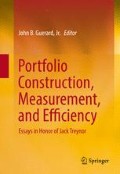Abstract
In an article published in the Financial Analysts Journal (Treynor, 1987), Jack Treynor wrote about a series of “bean jar” experiments he conducted with students in his investments courses at the University of Southern California. In the first set of experiments, he asked students to independently estimate the number of beans contained in a full jar. While most students’ individual estimates missed the actual number by a wide margin, surprisingly, the average estimates were pretty close to being correct. In the second set of experiments, he first provided students with advice on properties of the jar, such as the air space at the top of the jar, and materials of the jar. While such information supposedly could help improve the accuracy of students’ estimates, the resulting average estimates, alas, had much larger errors than those from the first set of experiments. It seems his advice did nothing more than cause common errors among students!
This work draws from, and adds discussion to, our Management Science publication, Wei, Wermers, and Yao (2015), with permission from Informs.
Access this chapter
Tax calculation will be finalised at checkout
Purchases are for personal use only
Notes
- 1.
- 2.
There is also a debate on whether herds indeed irrationally give up their own opinion and rely too much on certain influential common information sources. For example, Sias (2004) argues that herds merely infer information from each other’s trades.
- 3.
This value is calculated assuming, under the null of no herding in stock-quarter i,t, that funds trade randomly and independently of each other. With this assumption, p i,t can be assumed to follow a binomial distribution with parameters (n, \( {\overline{p}}_t \)), where n = the number of funds that trade stock i during quarter t.
- 4.
Note that RPI is the correlation, either positive or negative, between fund trading and public information.
- 5.
For example, Chen, Hong, Huang, and Kubik (2004) document decreasing returns-to-scale among mutual funds.
- 6.
Recall that buying stocks (selling stocks) with a lower buy-herding (sell-herding) measure means that the fund tends to trade against the crowd; i.e., the fund is more contrarian in its trading behavior.
References
Brown, K. C., Harlow, W. V., & Starks, L. T. (1996). Of tournaments and temptations: an analysis of managerial incentives in the mutual fund industry. Journal of Finance, 51, 85–110.
Brown, N. C., Wei, K. D., & Wermers, R. (2014). Analyst recommendations, mutual fund herding, and overreaction in stock prices. Management Science, 60, 1–20.
Carhart, M. (1997). On persistence in mutual fund performance. Journal of Finance, 52, 57–82.
Chen, J., Hong, H., Huang, M., & Kubik, J. D. (2004). Does fund size erode mutual fund performance? The role of liquidity and organization. American Economic Review, 94, 1276–1302.
Chen, H. L., Jegadeesh, N., & Wermers, R. (2000). An examination of the stockholdings and trades of fund managers. Journal of Financial and Quantitative Analysis, 35, 43–68.
Chevalier, J., & Ellison, G. (1997). Risk taking by mutual funds as a response to incentives. Journal of Political Economy, 105, 1167–1200.
Cremers, M., & Petajisto, A. (2009). How active is your fund manager? A new measure that predicts performance. Review of Financial Studies, 22, 3329–3365.
Daniel, K., Grinblatt, M., Titman, S., & Wermers, R. (1997). Measuring mutual fund performance with characteristic-based benchmarks. Journal of Finance, 52, 1035–1058.
Daniel, K., Hirshleifer, D., & Subrahmanyam, A. (1998). Investor psychology and security market under- and over-reactions. Journal of Finance, 53, 1839–1886.
Dasgupta, A., Prat, A., & Verardo, M. (2011a). The price impact of institutional herding. Review of Financial Studies, 24, 892–925.
Dasgupta, A., Prat, A., & Verardo, M. (2011b). Institutional trade persistence and long-term equity returns. Journal of Finance, 66, 635–663.
Fama, E. F., & MacBeth, J. D. (1973). Risk, return, and equilibrium: Empirical tests. Journal of Political Economy, 81, 607–636.
Huang, J., Sialm, C., & Zhang, H. (2011). Risk-shifting and mutual fund performance. Review of Financial Studies, 24, 2575–2616.
Kacperczyk, M., & Seru, A. (2007). Fund manager use of public information: New evidence on managerial skills. Journal of Finance, 62, 485–528.
Kacperczyk, M., Sialm, C., & Zheng, L. (2005). On the industry concentration of actively managed equity mutual funds. Journal of Finance, 60, 1983–2011.
Lakonishok, J., Shleifer, A., & Vishny, R. (1992). The impact of institutional trading on stock prices. Journal of Financial Economics, 32, 23–43.
Sias, R. W. (2004). Institutional herding. Review of Financial Studies, 17, 165–206.
Surowiecki, J. (2004). The wisdom of crowds: Why the many are smarter than the few and how collective wisdom shapes business, economies, societies and nations. Doubleday.
Treynor, J. (1965). How to rate the management of investment funds. Harvard Business Review, 43, 63–75.
Treynor, J. (1987). Market Efficiency and Bean of Jar Experiment Financial Analyst, 43, 50–53.
Treynor, J., & Mazuy, K. (1966). Can mutual funds outguess the market? Harvard Business Review, 44, 131–136.
Wei, K. D., Wermers, R., & Yao, T. (2015). Uncommon value: The characteristics and investment performance of contrarian funds. Management Science, 61, 2394–2414.
Wermers, R. (1999). Mutual fund herding and the impact on stock prices. Journal of Finance, 54, 581–622.
Wermers, R., Yao, T., & Zhao, J. (2012). Forecasting stock returns through an efficient aggregation of mutual fund holdings. Review of Financial Studies, 25, 3490–3529.
Author information
Authors and Affiliations
Corresponding author
Editor information
Editors and Affiliations
Rights and permissions
Copyright information
© 2017 Springer International Publishing Switzerland
About this chapter
Cite this chapter
Wei, K.D., Wermers, R., Yao, T. (2017). Against the ‘Wisdom of Crowds’: The Investment Performance of Contrarian Funds. In: Guerard, Jr., J. (eds) Portfolio Construction, Measurement, and Efficiency. Springer, Cham. https://doi.org/10.1007/978-3-319-33976-4_19
Download citation
DOI: https://doi.org/10.1007/978-3-319-33976-4_19
Published:
Publisher Name: Springer, Cham
Print ISBN: 978-3-319-33974-0
Online ISBN: 978-3-319-33976-4
eBook Packages: Economics and FinanceEconomics and Finance (R0)

